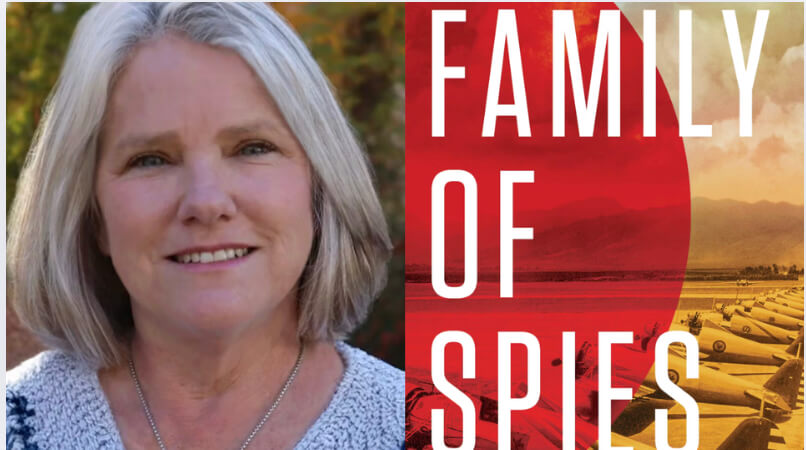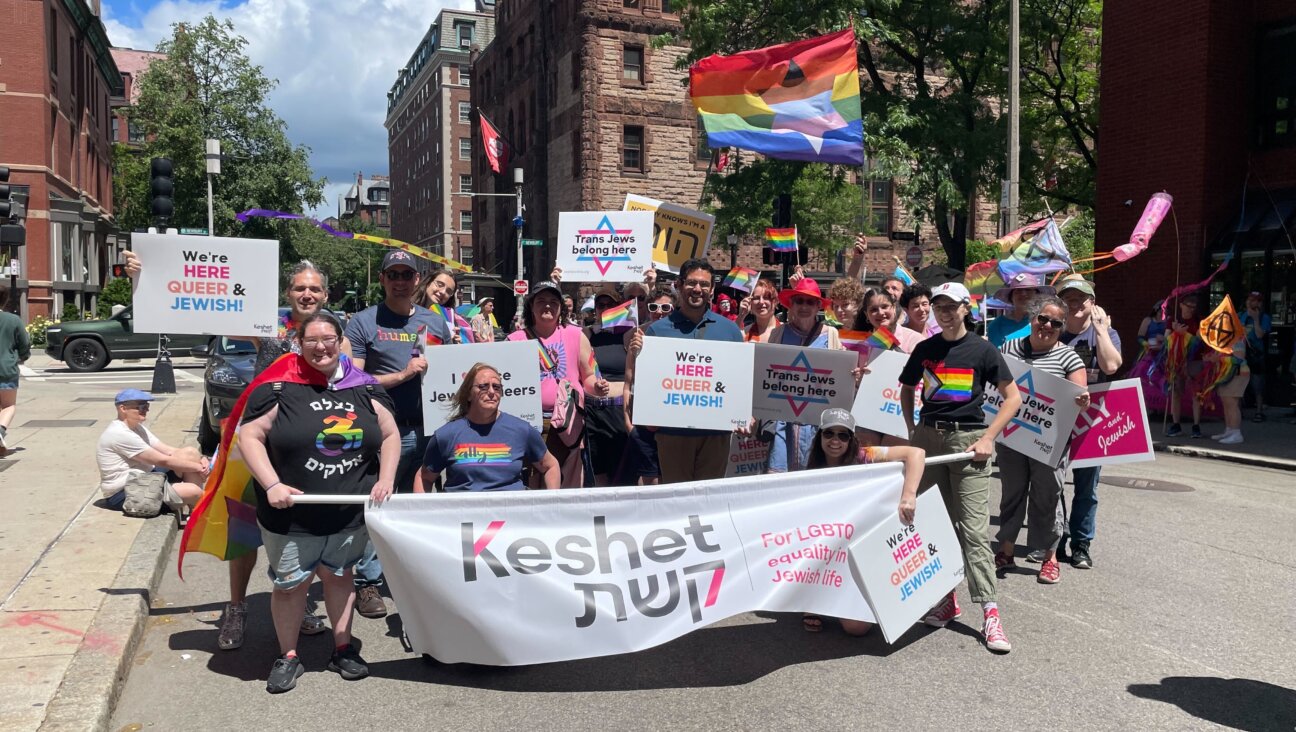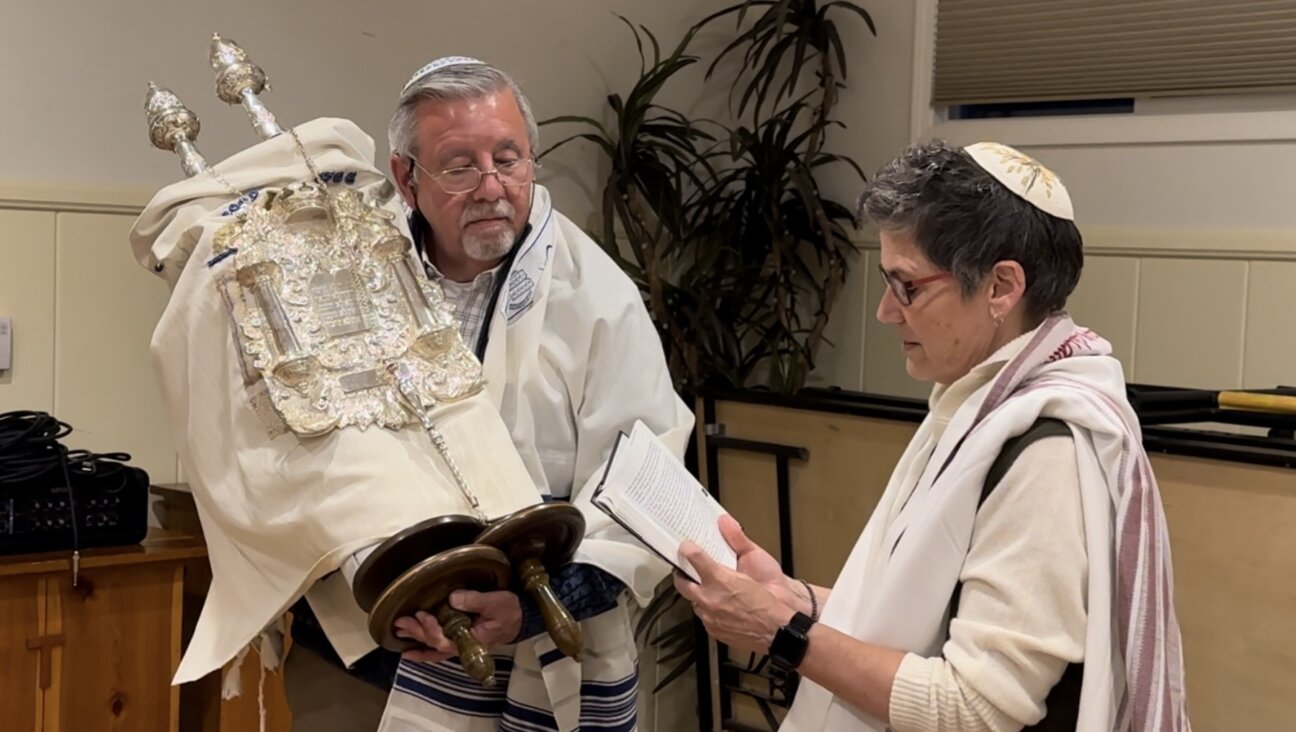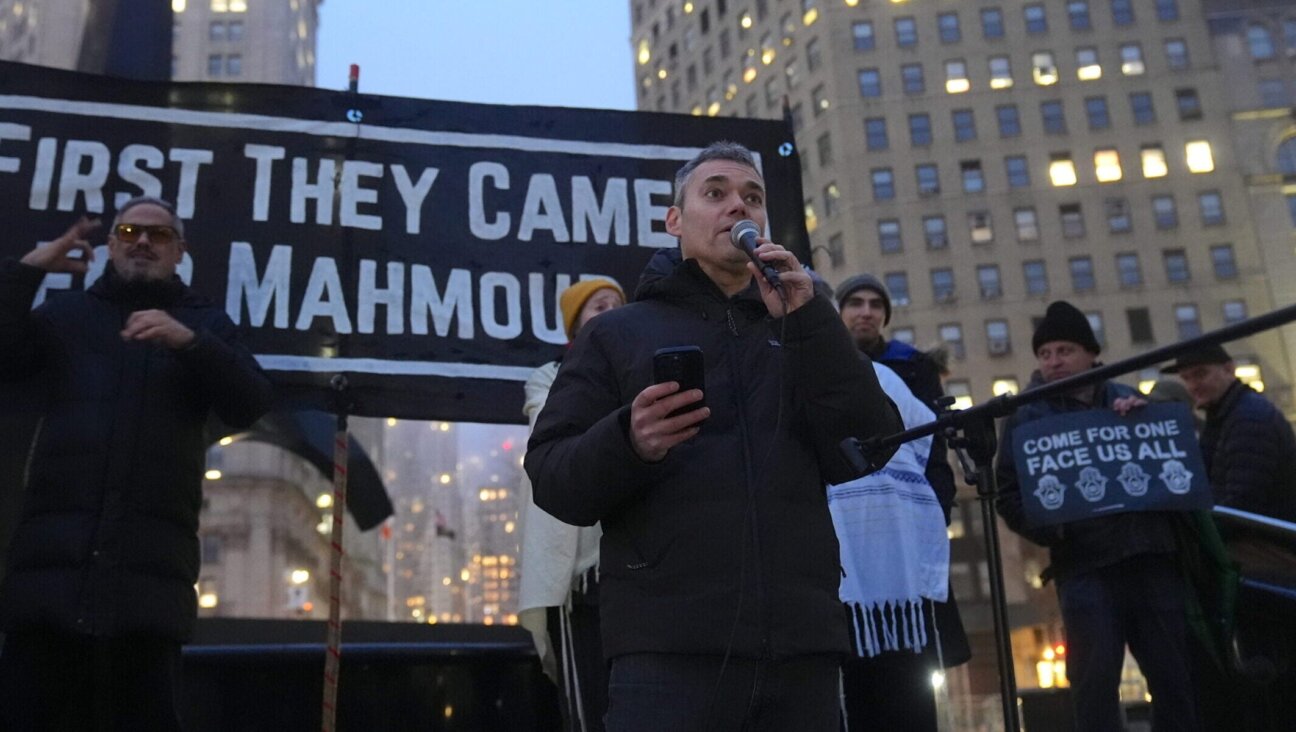These Frum Filmmakers Are Revolutionizing Orthodox Cinema

Image by Nikki Casey
The Haredi world is generally viewed as an insular patriarchal community that shuns movies. Virtually nobody owns a TV. Still, a fledgling, shadow film industry has been growing quietly for a decade within the confines of this improbable universe. These flicks — dozens of them — are produced, scripted, directed and performed by women. Female owned production companies provide everything from cinematography to editing to animation services.
And audiences have been lining up for showings in huge halls not simply in Brooklyn’s Boro Park and Crown Heights, but also in Orthodox enclaves across the globe, typically during the winter months and holiday time, when wives, moms and daughters are looking for a break.
DVDs sell briskly at such major Judaic distributors as the Brooklyn-based Mostly Music and other specialty outlets — Eichlers, for example. “Intended for Women & Girls Only” is clearly printed on the package. Haredi men are not allowed to look at performing women — or at pictures of women — to whom they are not related.
Like the community’s most successful publications that are also helmed by women, they reflect a complex subculture awash in contradictions and the unexpected.
“When I started I couldn’t even use the word ‘movie’ or ‘film,’” writer-director Ronit Polin recalled. “I called my first movie ‘a drama on screen,’ and later ‘screen drama’ or ‘filmed drama,’ until finally it became acceptable to use the word ‘film.’ The name evolved as community acceptance grew.”
Miriam Leah Gamliel, who heads The Association for Torah and the Arts for Religious Artists, in Montreal, said: “If anything is revolutionary it’s that these filmmakers have transformed the meaning of the word ‘movie’ from something formerly corrupt into its otherwise neutral meaning and in so doing changed the community’s perception of the word. That’s certainly remarkable, if not revolutionary.”
“The making of films and the showing of films are revolutionary,” said Shulamit Reinharz, the Jacob Potofsky Chair of Sociology at Brandeis University, and director of the Hadassah-Brandeis Institute. “But so is the fact that women are creating these films with their husbands’ support. That’s huge not simply for them, but also for their children.”
The women-driven stories on screen run the gamut from historical narratives to domestic dramas; many films teach moral lessons — for example, all words and deeds have a ripple effect; God has a plan, and everything happens for a reason. “Bad” characters are usually redeemed. Non Jews (if they’re present at all) are often “the other,” but they may also be good, redeemed if they’re bad and/or secret Jews. Issues such as bullying and intolerance are touched on, and films have featured characters with autism and Down syndrome. But mean-spirited exposés have no place; scandal, violence and sexual content are out.
Filmmakers have set their stories in all-girl worlds such as schools, camps and orphanages. Male characters on screen are few and far between. Men and women performing together on screen — or stage — are unacceptable. Sometimes, actresses will play men, though that Elizabethan trend in reverse is increasingly uncommon. Many directors who initially employed cross-dressing have dropped the practice because it looks silly and amateurish. Also, the image of girls sporting pants (no matter how loose fitting) may be troubling to some viewers, as trousers on women are not considered modest.
Some directors will employ men in background shots (cashiers and police, for example), and a few may dare to feature men and women in the same
frame (that’s rare), though the actor would never be a young romantic lead; he might be a father figure or someone elderly.
Among the filmmakers I interviewed, nobody saw her own views as markedly different from those of her audience.
“I want my audiences to be entertained, but at the same time I’m determined to give them meat and potatoes, a script of value that has substance,” Polin said. “My challenge is not to sound preachy. I also feel a sense of responsibility to the actresses in giving them an outlet for creative expression that they wouldn’t have otherwise.”
“The audiences demand material that’s inspiring and meaningful,” filmmaker Robin Garbose added. “They’ve come to expect that.”

Waiting at the Bus Stop: A Scene from “The Heart That Sings,” a musical written and directed by Robin Garbose. Image by Courtesy of Robin Garbose
•
Haredi films tend to be low budget — ranging from $100,000 to $300,000 — and the quality varies, though for the most part, production values are on a fairly high level and the acting is not half bad. There are now special camps and training programs in the States and Israel for aspiring ultra-Orthodox female film directors, screenwriters and actresses.
The best known of these in the States are the Los Angeles-based Kol Neshama and the Tzohar Seminary for Chassidus and the Arts, in Pittsburgh. The former, a 16-year-old program (established by Garbose) provides training for girls and women in a Torah-observant setting. To date, more than 400 girls have come through the program. The goal is to forge a cadre of artists who will embody a new voice that marries high-level professionalism with Haredi values in theater and film.
Founded in 2011, the Tzohar Seminary offers female high school graduates a year of art, writing, performance (acting, dance, music) and filmmaking in addition to Judaic studies, focused mainly on Chassidus, a mystical take on Jewish learning, “which I believe is closely allied to the arts,” said the school’s founder and director, Amy Guterson. “In exposing our students to all of the arts, we’re raising existential questions and exploring personal growth.”

On Set: Ronit Polin’s “Ink” concerns a young Jewish girl living in disguise in a Nazi’s home. Image by Courtesy of Ronit Polin
•
So, what has spawned this film movement? Most obviously, there’s the trickle-down effect from the culture at large; also, women’s expanding role in society; the growing appreciation of self-expression; the accessibility of low-cost do-it-yourself film equipment, and the ubiquity of the internet.
The internet has its positive and negative aspects. It has made information from nonkosher websites widely available — kosher filters don’t filter out everything — but it also serves as a platform for remediation or (depending on your viewpoint) as an electronic forum to celebrate and spread the virtues of Haredi lifestyles.
Tradition has played a role in the birth of this film industry, too. For decades, slideshows — narratives told through pictures and voice-overs — were considered good public entertainment within the ultra-Orthodox world. Men made most, but women were doing them, too.
Similarly, “kosher” theater (typically yeshiva-based productions) for girls and women has always been popular. Brooklyn-based theater producer Miriam Handler was a pioneer filming her staged musicals early on, and her DVDs continue to be sell well.
In addition to Polin and Garbose, this new breed of filmmakers includes Yuta Silverman, Rachel Frankl, Malky Weingarten, Lara Gedzelman and Tobi Einhorn in the States, and Dina Perlstein and Tali Avrahami in Israel. They are an amalgam of FFBs (frum from birth) and BTs (baal teshuvas, returnees to religious Judaism) who’ve had exposure to the world beyond, working in secular films and/or taking filmmaking and acting classes outside the religious community (along with participating in yeshiva high school productions).
Some have attended secular plays, ballets, concerts and even films, most notably Rama Burshtein’s prize-winning “Fill the Void,” a depiction of Haredi life in an Israeli family. They all said it was cool to see a turbaned, matronly clad Haredi woman strolling down the red carpet at film festivals.
Silverman’s first foray into cinema came as the result of an epiphany. “Ten years ago, it just popped into my head. ‘I’m going to make a film,’” she recalled. “When I told my family, their reaction was, ‘Oh, well, another one of Yuta’s out-of-the-box ideas.’”
Her maiden endeavor, “Arranged,” centered on a friendship between two women, one ultra-Orthodox and the other Muslim, both of whom are facing the prospect of an arranged marriage.
Polin, generally recognized as the first frum filmmaker in the United States, launched her career in 2006 when a charity proposed shooting a staged production of one of her plays. “It occurred to me, why do I need a living room on a stage in order to film a living room,” she said. “Why not just film the scene in a living room? When I said I’d do a real film, it ultimately didn’t work out with the charity, but the spark was ignited and I decided to write, direct and produce a film on my own. I spoke to my Hasidic friends and they were all for it. Still they were shocked. ‘Will people on screen really walk and talk at the same time?’ they asked. Such innocence.”
Polin’s first film, “Ink,” tells of a young Jewish girl who, living incognito in the home of a Nazi, uses ink (the power of the pen) to save her people. The movie marked a turning point in entertainment for the ultra-Orthodox. “Ink” led to Polin’s second outing, “Diamonds in the Dust,” which was produced with financial assistance from the Chofetz Chaim Heritage Foundation and opened in 70 cities during its first week.
Polin, who established her own company, FlyingSparks Productions, served most recently as the development producer of the docu-series “Arranged” (FYI Network), which explores arranged marriages and presents an Orthodox couple, heralding the first time that Orthodox Jews are featured on a regular season of unscripted TV.
Most of the filmmakers have received both financial and emotional support from their families. One director admitted that if her husband did not support her efforts, she would not risk her marriage to do a film. Another, who clearly has no intention of quitting her film career, emailed me in the middle of the night to cancel our interview because her husband did not want her to receive media attention.
•

Anonymous Benefactor: A Brooklyn family falls on hard times until the titular benefactor comes to their aid. Image by Courtesy of Rachel Frankl
Many filmmakers live in or around Boro Park, where I met with them in Orthodox-owned restaurants, near aging two- and three-story buildings tacked over with signs written in Yiddish and within walking distance of the mammoth, rusting El.
Garbrose (“A Light for Greytowers,” “Operation: Candlelight,” “The Heart That Sings”) spoke to me on the phone from her home in Los Angeles. She has TV credits under her belt, and Hollywood connections. She says Warner Bros. gave her $100,000 in “in kind” support for her first film, meaning rent-free costumes, sets and props.
Garbose was among the first to employ actors in her films, “though very carefully and with rabbinical guidance,” she said. “In one film we had two actors playing a husband and wife. But the actors were married, and in the opening credits we had their names next to their pictures so that the audience would not feel uncomfortable if the two actors were looking at each other in the same frame.”
Garbose is best known for her musical films — she collaborates with her husband, composer Levi Yitzhak Garbose. “Most singing that we see on Orthodox videos is presented in a recital style with a limited vocal range,” she said. “We’re a stylistic departure. But really, when you think musical theater, its roots are Jewish composers and before that, Yiddish theater.”
But most central to Garbose’s sensibility is a celebration of “girl power.” In “Operation Candlelight,” for example, several young girls join forces and hunt down a terrorist and his drug-dealing Mexican cartel pals. Thanks to the girls’ efforts, the bad guys are arrested.
Garbose submits her movies to Jewish film festivals, shows them at fundraising premieres — her first flick, “A Light for Greytowers” premiered at the Sherry Lansing Theater, in L.A., — and is optimistic about a mainstream picture she’s been working on. Should it hit the big screen, “Spark,” dealing with one young woman’s Jewish rebirth and renewed spirituality. would represent the first Jewish contribution to the genre of faith-based films traditionally identified with fundamentalist Christians.
While Garbrose and Polin are full-time filmmakers, others have day jobs. Silverman is a reading teacher at religious schools, and Frankl runs a home-based bakery with her young daughter.
Frankl is currently working on her third film, and says she has no interest in a movie career outside the Haredi community.
“I want the Haredi film business to grow and become relevant,” she said. “The rest of the film world — from Hollywood blockbusters to indies to foreign movies — has its prominent niches, and I really want that for the Haredi film world, too.”
Jewish identity and its politics are intrinsic to who these artists are and play a role, in every aspect of their professional lives: These women don’t work on the Sabbath, and they let Jewish ethics guide the content of their films.
“If I’m telling a story about an Orthodox Jew, I’d be conflicted, for example, over whether it’s okay to show her getting undressed in her bedroom, even if that’s what she might be doing,” Silverman said. “Would it make any difference if the character or actress is not Jewish? I don’t know. I’m thinking about these issues all the time. If I’m not sure, I will talk with my rabbi.”
Rabbis may or may not review films before they are released. In theory, ultra-Orthodox rabbis cannot be looking at pictures of women. Still, some filmmakers said rabbis had seen their films or at least read the scripts. Usually, a respected female in the community, such as a school principal or teacher, will preview a film and put her stamp of approval on it; all advertising copy includes her comment, thus making the film more comfortable for viewers to attend.
When Garbose presented “A Light in Greytowers” in Boro Park with rabbinical blessings and no shortage of buzz — it had been previously shown in Crown Heights — there was a mob scene outside Menorah Hall. “Still, I was a little worried,” she said. “Crown Heights and Boro Park are not the same. Crown Heights is home of the Chabad Lubavitch and they are more open than the residents in Boro Park.”
The movie — a musical about a young Jewish girl in a Victorian orphanage who fights for her faith against all odds and prevails — was a hit with the Boro Park audience. But at the question-and-answer session that followed, one irate woman wanted to know why there was a man in the film. Within short order, Garbose had received a call from her booking agent, saying the film was going to be shut down.
“Ultimately that did not happen,’” Garbose recalled. “Instead they hung posters all over Flatbush with a disclaimer in Yiddish saying, ‘It’s not forbidden, but it doesn’t meet our standards.’ That turned out to be the best publicity we could have. We sold out and had to add a 10 p.m. screening with 800 more women waiting to get in. That was our greatest victory against people on the right. But we’ve also managed to offend people on the left and triumphed.
“We were invited to be part of the film festival at the Jerusalem Cinematheque, the bastion of secular films. I made it clear that my film had to be marketed for ‘women and girls only,’ at which point we were disinvited on the grounds that we were discriminating against men. We face this problem with many festivals that are big on diversity except when it comes to religious Jewish women.In the end we screened our film at a theater across the street.”
It is difficult to estimate how much money this sub-industry is generating. Garbose admitted that she is not yet making a profit. Most of the funding comes from the filmmakers themselves and from other private donations, including crowd-sourcing. But even once the money is in place it can still take several years to get a film made.
Some Brooklyn filmmakers run casting notices in local papers and hold auditions. This can become a long and tedious process, particularly when hundreds of women show up.
All actresses and female crew — some of whom are not Jewish — are told they’ll have to conform to Haredi dress codes that include skirts worn below the knee, stockings and loose-fitting long-sleeved tops, even in the summer.
“Everyone has been very accommodating,” Frankl said. “When a non-religious Jewish actress asked about our film, and we explained we were hoping to give Haredi women — who would never audition for a secular film —the chance to act, she was touched and encouraged us to cast someone frum.”
The religious actresses have short-lived careers. They’re free to appear in frum films as adults, but they will never make a living at it. And, should they choose to pursue secular acting careers, they run the risk of being ex-communicated.
Claude Marquis, mother of 16-year-old actress Raize Marquis, who appeared in “Operation: Candlelight,” said: “I’m very proud of my daughter’s talent and her passion. I’m also grateful that there is a vehicle for her to pursue it in a religious context. Raize understands that she can do this as long as her audience is women only. She knows this will not be a career for her.”
Raize Marquis agreed. “I’ve always loved acting, but being part of the religious community is more important to me,” she said. “Maybe I’ll be a doctor.”
Twenty-something actress Rivka Siegel Krinsky (“Operation: Candlelight,” “The Heart That Sings,” “A Light for Greytowers”) was more ambivalent. “I haven’t fully given up,” she said. “I wouldn’t have a problem performing with men if it were done modestly, no touching. It’s also no problem for me if a secular audience that includes men views a film I’m in, though I wouldn’t sing in the film, wear pants or take my wig off, whether or not the character I was playing was married or even Jewish. Acting is my craft and I love it. But in essence, I’m Chabad.”

Rachel Frankl Image by Courtesy of Rachel Frankl
•
Israel also has a thriving “for women and girls only” film scene. It has much in common with its counterpart here, though the stories are often more melodramatic and the budgets tend to be larger.
Launched around 2000, the film industry began largely out of financial necessity. Families needed more money to survive, and Haredi women, many of whom were directing plays, branched out to create movies.”
“It’s not the feminist movement that shaped the evolution of the women’s films in Israel, but the openness to modernity, to technology and to secular cinematic culture,” said Matan Aharoni, an expert on community-based Haredi films and a lecturer at the Sammy Offer School of Communications Interdisciplinary Center, in Herzliya, Israel.
Still, virtually no film within the frum community gets underway without a rabbinical blessing, and the best- known filmmakers do not allow their DVDs to be sold or streamed online. They want to maintain a degree of insularity, and at the same time some of the directors are producing films in English and Hebrew, anticipating global audiences.
The Jerusalem-based Ma’aleh School of Television, Film & the Arts has inaugurated a special program for Haredi women who want to be filmmakers.
According to Neta Ariel, the school’s director, the program should bring a new level of professionalism to the world of Haredi films, one “that may even go mainstream. These new movies may well function as the bridge.”
•
What’s strikingly absent on both continents are male directors producing theatrical films for frum boys and men (which would also be available to girls who are not prohibited from looking at pictures of men). The reasons cited were limited time and not enough income earned to make it worth the effort.
Further, the kind of “small” character-driven movies that are affordable to newbie producers and directors might prove to be of little interest to most men if they were attending movies at all.
Women clearly have the upper hand here. Still, how the community defines these women filmmakers in Israel and the States is ambiguous. They’re playing a brand-new role with no real precedent.
Many say they are “leaders” of some sort and believe that their audiences view them that way. Others suggest that they slipped under the radar and are largely invisible, and that is a virtue, too.
All the filmmakers reported enthusiastic audiences who sent them grateful emails or thanked and praised them on the street for their work.
“They’ve all grown into little critics,” Frankl said, laughing. “They’re not only talking about the acting, but also the costumes, lighting and sets. It’s wonderful.”
“These women are far more sophisticated than most people give them credit for,” Garbose said of her audience.
Some filmmakers I spoke with said their films will maintain their religious values even as they continue to improve technologically; others said their films will slowly accommodate aspects of the contemporary. All agreed that these films represent a new opening and may be seen by a far wider audience than one might imagine. The Haredi world will become increasingly visible in mainstream media.
In the meantime, the filmmakers have their ambitions set on the local front. Frankl would love to see a regularly held festival of frum films in Boro Park or Crown Heights. She’d also like to run her own year-round space for movie showings. Renting is the first step. “Owning a theater would even be better,” added Silverman.
Simi Horwitz, who has won numerous New York Press Club and Simon Rockower Awards, is the author most recently of ‘Jewish Art Today: News, Views and Cultural Trends’ (Hadasa Press).















